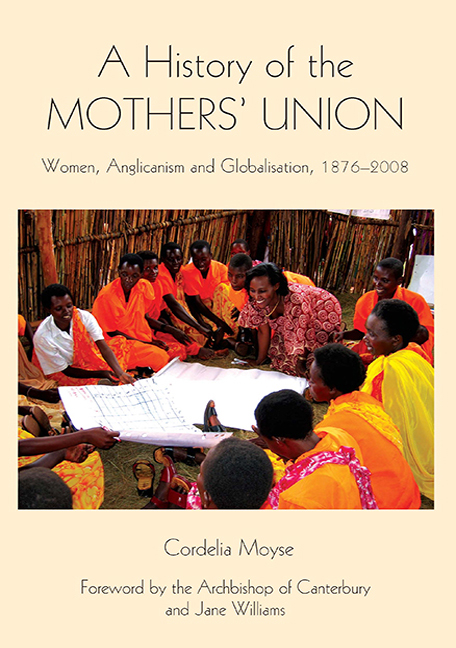Book contents
- Frontmatter
- Contents
- Dedication
- List of Illustrations
- Foreword by the Archbishop of Canterbury and Jane Williams
- Acknowledgements
- Abbreviations
- Introduction
- Part I 1876–1909
- 1 Launching the Mothers’ Union
- 2 Identity and Spirituality
- 3 Marriage and Family Life
- 4 Membership and Worldwide Work
- Part II 1910–1944
- Part III 1945–1974
- Part IV 1975–2008
- Conclusion
- Appendix 1 Text of early membership cards
- Appendix 2 Development of the Mothers' Union prayer
- Appendix 3 Midday prayers (original)
- Appendix 4 Development of the objects
- Appendix 5 Biographical notes on central and worldwide presidents
- Bibliography
- Index
- Miscellaneous Endmatter
2 - Identity and Spirituality
from Part I - 1876–1909
Published online by Cambridge University Press: 29 April 2017
- Frontmatter
- Contents
- Dedication
- List of Illustrations
- Foreword by the Archbishop of Canterbury and Jane Williams
- Acknowledgements
- Abbreviations
- Introduction
- Part I 1876–1909
- 1 Launching the Mothers’ Union
- 2 Identity and Spirituality
- 3 Marriage and Family Life
- 4 Membership and Worldwide Work
- Part II 1910–1944
- Part III 1945–1974
- Part IV 1975–2008
- Conclusion
- Appendix 1 Text of early membership cards
- Appendix 2 Development of the Mothers' Union prayer
- Appendix 3 Midday prayers (original)
- Appendix 4 Development of the objects
- Appendix 5 Biographical notes on central and worldwide presidents
- Bibliography
- Index
- Miscellaneous Endmatter
Summary
To organise in every place a band of mothers who will unite in prayer and seek by their own example to lead their families in purity and holiness of life.
(Third object, 1896)Despite coming last, the third object of the Mothers’ Union – to be united in prayer and to lead by example – was its core purpose. The first two objects – to uphold the sanctity of marriage, and to awaken in all mothers a sense of their great responsibility in the training of their boys and girls – were its outworking. Sumner constantly described the MU as a prayer union. Faithful discipleship, not meeting attendance, was supposed to be the hallmark of membership. Yet words like ‘prayer’, ‘example’ and ‘holiness of life’ require explanation as they are far from singular in either meaning or expression. Christian spirituality comes in most shapes and sizes, with religious devotion expressed through such things as Bible study, prayer and public worship, but that is only a part of ‘living like a Christian’. Christian living also includes ‘the way devotional lives are worked out in practice, in the interaction of the spiritual and physical’. To grasp any model of Christian discipleship one needs to understand its theology, its proposed audience and the institutional context in which it exists. With this holistic understanding of discipleship and spirituality, this chapter explores the sources and model of Christian life that the MU promoted to its membership.
MU spirituality was forged in the context of a lay women's organisation in a Church proud of its via media, the middle way it chose to walk though the religious disputes of the Reformation. The Church of England described itself as a Catholic but Reformed Church. As a women's organisation seeking to release the power of mothers for the spiritual and moral benefit of the family and the nation, the MU managed successfully to create a female space in a historically male and highly clerical church. It was an organisation which attracted broad support within the Church but, unlike many new initiatives in women's ministry at that time, was uncontentious. It achieved this in two ways. The first was by presenting itself as an intrinsically Anglican organisation and not the creature of one particular church party.
- Type
- Chapter
- Information
- A History of the Mothers' UnionWomen, Anglicanism and Globalisation, 1876–2008, pp. 43 - 61Publisher: Boydell & BrewerPrint publication year: 2009



